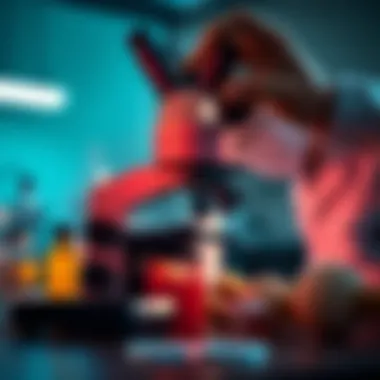Exploring the Link Between Science and Justice in Court


Overview of Research Topic
The convergence of science and justice is a captivating area of exploration, especially in today’s world where the implications of forensic advancements are profound. Courtroom science incorporates various scientific disciplines, such as biology, chemistry, and technology, which amalgamate to form an integral part of legal proceedings. As the boundaries of traditional evidentiary practices are stretched by technological revolutions, understanding this intersection has never been more critical.
Brief Background and Context
In many respects, forensic science stands at the crossroads, navigating the delicate balance between the pursuit of truth and the intricate nuances of legal frameworks. Historically, forensic methodologies were limited in their scope and effectiveness. However, rapid advancements—such as DNA profiling, digital forensics, and advanced ballistic techniques—have revolutionized crime scene investigations and trials. This evolution has ushered in new challenges, forcing courts to adapt and reevaluate the admissibility and reliability of scientific evidence.
Importance in Current Scientific Landscape
The importance of courtroom science in our contemporary legal environment cannot be understated. As technology burgeons, so does the complexity of cases in which scientific evidence plays a vital role. The methods employed in these cases often impact the lives of individuals profoundly. These technologies not only raise questions about the reliability of evidence but also ethics in their application. Understanding this landscape helps students, researchers, educators, and professionals appreciate the critical role science plays in facilitating justice.
Methodology
Research Design and Approach
The approach taken in this exploration involves a comprehensive review of literature across various scientific disciplines as they relate to courtroom practices. It also examines case studies, legal precedents, and scholarly articles to synthesize a clear narrative on the interplay between science and justice. By diving into both successful and contentious case outcomes, insights emerge that highlight the strengths and weaknesses of courtroom science.
Data Collection Techniques
Data for this analysis were garnered from a multifaceted approach:
- Literature Review: An extensive survey of academic databases such as Google Scholar, JSTOR, and legal archives like Westlaw can provide a treasure trove of information.
- Case Studies: Evaluating landmark cases that depended heavily on scientific methodologies highlights practical applications and consequences.
- Interviews: Engaging with professionals in both scientific and legal fields can provide unique perspectives on the effectiveness and challenges of courtroom science.
Understanding these elements offers a detailed view of how empirical evidence and scientific principles are increasingly shaping the justice system, paving the way for further developments in the realm of courtroom science.
"The future of legal proceedings will revolve not just around laws, but about how well we can interpret and apply science in the pursuit of justice."
For further insights, visit The National Academies Press for important publications that delve into forensic science and its influence on the judicial system.
To explore milestones and case studies in forensic science, check out Wikipedia's entry on Forensic Science.
Additionally, discussions on scientific principles in legal frameworks can also be found on forums like Reddit's Legal Advice.
Through this analysis, the article aims to present a well-rounded understanding of how scientific inquiry drives the judicial process.
Defining Courtroom Science
Courtroom science represents the crossroads where rigorous scientific methodology meets the judicial process. Understanding this intersection is paramount, as it underscores how scientific principles can be utilized to establish facts, corroborate narratives, and ultimately aid in the quest for justice. The field of courtroom science not only embodies the application of various scientific methods but also reflects the ongoing evolution of legal frameworks influenced by advancements in science and technology.
The Role of Science in the Legal System
Science serves as a linchpin in the legal system, providing a means to validate evidence and strengthen arguments. The infusion of scientific rigor into legal proceedings helps ensure that decisions are based on substantiated facts rather than mere conjecture. For instance, DNA evidence can link a suspect to a crime scene, elucidating the facts surrounding a case with a degree of precision that is hard to contest.
Moreover, the credibility lent by scientific involvement can enhance public trust in judicial outcomes. In a world increasingly plagued by misinformation, the reliance on clear, testable scientific facts imparts a sense of reliability to legal processes. However, the relationship isn't always straightforward. Courts often grapple with the interpretation of scientific data, which can be complex and fraught with nuances.
Key Scientific Disciplines in Forensics
Each scientific discipline offers its unique tools and methodologies in the realm of forensics, creating a multi-faceted approach to evidence collection and analysis.
Biology
Biology plays a crucial role in forensic science, particularly in analyzing biological materials such as blood, saliva, and hair. The key characteristic of biology in this field is its ability to provide definitive proof of identity through DNA analysis. Biology is a beneficial choice for courtroom science because it can connect individuals to crime scenes through genetic markers that are nearly unique to each person.
A unique feature of biological sciences is the capacity for exclusion; if biological evidence does not match the DNA profile of a suspect, it can effectively rule that person out as a potential perpetrator. However, this area is not without issues, as contamination during evidence collection can lead to irrevocable errors.
Chemistry
Chemistry’s role in forensic science often revolves around the analysis of chemical substances, including drugs, explosives, and toxins. The key characteristic of chemistry is its methodical approach to breaking down complex materials into identifiable components. It is particularly popular in courtroom contexts, as the chemical composition of a substance can determine its legality in many jurisdictions.
In this context, a unique feature of chemistry is its reproducibility; the same methods can yield similar results across different tests, lending weight to the findings. The downside, however, stems from potential misinterpretation of results, particularly in cases involving mixtures of substances.
Physics
Physics provides essential insights into various investigative fields, especially ballistics and accident reconstruction. The key characteristic of physics in courtroom science lies in its principles governing motion and force. Understanding these principles allows forensic experts to reconstruct events with surprising accuracy. For example, trajectory analysis can clarify the positions of shots fired in a shooting case.
A unique feature of physics is its reliance on measurable quantities. However, as with any discipline, there can be disadvantages, such as the limitations imposed by real-world variables that influence the outcomes during physical investigations.
Digital Forensics
The burgeoning field of digital forensics has become increasingly prevalent, given the rise of technology in everyday life. Digital forensics involves recovering and investigating material found in digital devices, from computers to smartphones. The key characteristic here is the ability to extract detailed information from digital evidence, which can be pivotal in modern criminal cases.
Its unique feature is the breadth of data it can encompass, from emails to browsing histories, providing an intricate view into suspects' behaviors. However, the rapid pace of technological change poses significant challenges; by the time methods are standardized, newer technologies may have emerged, leading to questions about the adequacy of evidence.
As the importance of science in the legal system continues to grow, recognizing these scientific disciplines and their specific contributions becomes crucial in understanding courtroom dynamics. Each field, with its strengths and limitations, plays a vital role in bolstering the integrity of the judicial process.
Forensic Evidence Explained
Forensic evidence plays a pivotal role in the judicial unfolding of truth and justice. It provides tangible links to the crime scene, the suspect, or the victim, assisting attorneys in building their cases or defenses. This subsection digs into the specifics of forensic evidence, outlining its various types and the methods employed to collect and preserve it, which are essential in ensuring the integrity of judicial outcomes and the pursuit of justice.
Types of Forensic Evidence


Forensic evidence is not a monolith but rather a collective term encompassing diverse types of evidence. Each type contributes uniquely to criminal investigations and trials, bringing its own strengths and weaknesses to the table.
Physical Evidence
Physical evidence includes tangible objects from the crime scene. This could be as straightforward as a weapon or as intricate as fibers found on a victim's clothing. The key characteristic of physical evidence is its objective nature—it can be seen and measured, making it a reliable form of evidence.
A crucial facet of physical evidence is its ability to directly link a suspect to a crime. For example, fingerprints found on a gun can conclusively place an individual at the scene of the crime. However, one must be cautious about the context in which physical evidence is found; without proper chain of custody, its credibility can be called into question.
Advantages:
- Objective and verifiable; does not rely on witness testimony.
- Can provide definitive links between suspects and crime scenes.
Disadvantages:
- Vulnerable to contamination or misinterpretation if not handled properly.
- May not always be available depending on the nature of the crime.
Biological Evidence
Biological evidence refers to materials derived from biological sources; this includes blood, saliva, hair, and other bodily fluids. One of the defining attributes of biological evidence is its ability to provide DNA profiles, which can pinpoint an individual with astounding accuracy.
Biological evidence is particularly powerful due to its uniqueness. Even the faintest trace of blood can lead to a match through DNA analysis, which is often perceived as the gold standard in forensic science. Nevertheless, its collection and analysis require meticulous care to prevent degradation, emphasizing the need for rigorous protocols.
Advantages:
- Provides highly specific genetic information.
- Can be crucial in exonerating the falsely accused.
Disadvantages:
- Susceptible to contamination.
- Sometimes the quantity collected is insufficient for testing.
Trace Evidence
Trace evidence encompasses minute materials like hair, fibers, and glass fragments, often left behind unknowingly. The defining characteristic of trace evidence is its subtlety—these are not readily visible but can yield significant information when examined under a microscope.
The uniqueness of trace evidence is that it often serves as a breadcrumb trail leading investigators to a suspect, thus helping paint a more comprehensive picture of a crime. However, the challenge lies in the interpretation; trace evidence is not always conclusive, and contextual elements matter greatly in analysis.
Advantages:
- Can establish connections between people, places, and objects.
- Often collected in situations where larger evidence may not be available.
Disadvantages:
- Highly dependent on the skill of the analysts.
- Potential for ambiguity in matching materials.
Methods of Evidence Collection
In the intricate dance of courtroom science, the methodologies employed to gather evidence determine the quality and reliability of what will ultimately be presented in court. This underscores the importance of established protocols and techniques in forensic investigations.
Crime Scene Investigation
Crime scene investigation (CSI) is the first key step in the forensic evidence collection process. CSI teams meticulously document and analyze a crime scene, ensuring no detail goes unnoticed. One notable characteristic of this method is its systematic approach, often following the four Rs—recognition, recording, reconstruction, and reporting.
The strength of crime scene investigation lies in its comprehensive nature; every item is cataloged and preserved, reducing the risk of losing critical evidence. Yet, the process is not without its pitfalls; errors in handling or documentation can compromise an entire case, making training and expertise paramount.
Advantages:
- Creates a structured overview of the crime scene.
- Facilitates identification and collection of all potential evidence.
Disadvantages:
- Highly dependent on the expertise and objectivity of the investigating team.
- Can be impacted by environmental factors that may alter evidence over time.
Sample Preservation Techniques
Preserving samples is another vital aspect of forensic evidence collection. It ensures that evidence remains untainted for analysis later. Key characteristics of sample preservation techniques include temperature control, contamination prevention, and proper packaging. Being able to maintain sample integrity is crucial for valid results in court.
These techniques often involve using cool environments or specific containers designed to halt degradation processes. However, the specialized materials and protocols can be costly and require additional training and resources, which may not always be available in all jurisdictions.
Advantages:
- Helps ensure integrity and reliability of evidence for future analysis.
- Reduces risk of contamination which can lead to wrongful conclusions.
Disadvantages:
- Expensive; may require investment in specialized materials and training.
- Potential for human error in the preservation process.
Forensic evidence forms the backbone of modern justice systems. Without it, the roof that upholds the scales of justice would be tenuous at best.
In summary, forensic evidence, through its various forms and collection methods, serves as a crucial element in elucidating and unraveling the often complex narratives of criminal cases. Its reliable nature stands in stark contrast to human fallibility, driving the quest for truth and justice in every courtroom.
The Scientific Method in Courtroom Applications


The scientific method serves as a pivotal framework in the realm of courtroom science, where it aids in systematically discovering and verifying facts crucial for judicial proceedings. This method introduces a level of rigor that is essential in evaluating forensic evidence, allowing courts to draw not only conclusions but also to arrive at these conclusions via systematic investigation. Given the stakes involved in legal cases, employing the scientific method can enhance objectivity and bolster the credibility of evidence presented in court.
Hypothesis formation constitutes a cornerstone of this approach. In forensic cases, this process involves articulating a clear, testable statement that can be assessed through empirical observation. For example, if a certain type of fiber is found at a crime scene, a hypothesis could be that the fiber originated from a suspect’s clothing. This hypothesis sets the stage for investigations that can either validate or refute it.
Hypothesis Formation in Forensic Cases
Gathering evidence is half the battle; forming a sound hypothesis is the other half. In forensic science, a good hypothesis not only provides focus but also dictates the direction of the investigation. It leads forensic experts to design experiments that can confirm or deny the original claims. Often, a well-crafted hypothesis can illuminate various potential leads in a case, saving time and resources.
To illustrate, consider a case involving potential poison ingestion. The hypothesis might state, "The victim ingested a lethal dose of arsenic." Following this hypothesis, forensic toxicologists could test bodily fluids for arsenic levels, thus either confirming the hypothesis or proposing an alternate explanation.
Data Analysis and Interpretation
Data analysis and interpretation are vital components in the application of the scientific method within legal settings. Once evidence is collected and experiments conducted, the resulting data must be analyzed to yield meaningful insights that can inform the court.
Statistical Methodologies
Statistical methodologies play a crucial role in evaluating forensic data, providing insights that would be challenging to ascertain through intuitive judgment alone. These techniques allow forensic scientists to quantify uncertainty, which can significantly shape the legal narrative. For instance, the probability of a match between DNA samples can be expressed using statistical terms, rendering it easier for juries to comprehend.
The key characteristic of statistical methodologies lies in their ability to manage variability in data, providing a robust framework for decision-making. They are a popular choice in courtroom science because they lend analytical depth to claims made by forensic experts. Unique aspects such as regression analysis allow for a consideration of multiple contributing factors, while the calculation of confidence intervals helps in communicating the reliability of results.
However, the complexity of statistical methods can also be a double-edged sword. Misinterpretation of statistical significance can lead to incorrect conclusions, underscoring the need for careful presentation of results to judges and juries, who may lack statistical training.
Software Tools for Forensics
The advent of technology has ushered in a new era of software tools that enhance forensic analysis. These tools facilitate data processing, analysis, and visualization, simplifying complex data into informative formats. For instance, forensic software programs can assist in DNA analysis by automating pattern recognition, leading analysts to quicker and more accurate conclusions.
One key characteristic of these tools is their efficiency. They reduce the time it takes to analyze data, which can be critical in high-stakes cases. Additionally, many of these software programs are equipped with built-in algorithms that minimize human error during data evaluation, thereby increasing the reliability of findings.
Nonetheless, it’s important to recognize that reliance on technology has its pitfalls. Software bugs or errors can yield misleading results, and thus a forensic analyst must remain vigilant in verifying the findings produced by these tools. In a system where evidence can mean the difference between guilt and innocence, even minor software inaccuracies can have profound implications.
"Whether through hypothesis formation or the use of advanced statistical methodologies and software tools, the scientific method continues to play a vital role in enhancing the integrity of courtroom science."
Technological Advancements in Forensic Science
In the fast-evolving world of forensic science, technology has become an indispensable ally. The advancements in this field have not only refined traditional methods but also introduced innovative practices that significantly bolster the judicial system. The reliance on technology enhances accuracy, streamlines processes, and facilitates deeper connections between scientific evidence and legal outcomes.
Among various technological improvements, DNA profiling stands at the forefront. The ability to accurately identify individuals based on their genetic makeup has changed the landscape of criminal investigations. This method doesn't just pinpoint a suspect but can also exonerate individuals wrongfully accused. Additionally, the sophistication of artificial intelligence in forensic science is hard to overlook. With predictive algorithms and machine learning techniques, data can be processed much faster, leading to quicker resolutions in cases.
These advancements are not without consideration; ethical concerns often arise regarding data handling and the implications of artificial intelligence decisions in judicial contexts. However, the benefits such as improved evidentiary reliability and the potential for uncovering truth in complex cases make a strong case for the importance of technology.
DNA Profiling Techniques
DNA profiling techniques have revolutionized forensic investigations. What was once a lengthy and often error-prone process has been streamlined through advances in genetic analysis. Techniques like Polymerase Chain Reaction (PCR) allow forensic scientists to amplify minute quantities of DNA, making it possible to analyze even degraded samples.
The introduction of Next Generation Sequencing (NGS) has further enhanced the precision of DNA analysis. NGS facilitates the examination of multiple regions of the genome simultaneously, resulting in an enriched understanding of genetic markers. This technology not only aids in individual identification but can also uncover genetic relationships and ancestry, adding an additional layer to forensic evidence. The ongoing refinement of these techniques promises to bolster the reliability of evidence presented in court.
The Role of Artificial Intelligence
Artificial intelligence is carving out a significant niche in forensic science. Its capabilities for analyzing vast datasets efficiently make it an invaluable tool in contemporary investigations. AI systems can sift through mountains of data points far quicker than a human, identifying patterns that may not be readily apparent.
Predictive Algorithms in Crime Solving
Predictive algorithms serve as a unique feature of AI in law enforcement. By analyzing historical crime data, these algorithms can forecast where crimes are likely to occur, thus allowing resources to be allocated more effectively. This characteristic underscores the invaluable nature of predictive algorithms in driving proactive approaches to crime prevention. However, there's a need for caution. The reliance on historical data can reinforce biases if not handled with care. Hence, while predictive algorithms present a pathway to enhanced safety, the judicial system must continuously evaluate their deployment to avoid ethical pitfalls.
Machine Learning in Pattern Recognition
Machine learning has emerged as a vital cog in pattern recognition within forensic science. This technology allows for automatic learning and detection of anomalies in data sets, making it easier to identify behavioral patterns linked to criminal activity. For instance, machine learning algorithms analyze surveillance footage to differentiate between suspicious and non-suspicious movements.
A distinctive trait of this technology is its adaptability. As data accumulates, the systems improve, which bolsters efficacy in real-time applications. However, a drawback to consider is the potential for overfitting, where the model becomes too tailored to historical data and fails to generalize to new situations. This too is a reminder that technology must constantly be balanced with human oversight to ensure its application remains ethical and effective.
Ultimately, technological advancements in forensic science exemplify the symbiotic relationship between science and justice, enhancing the pursuit of truth and reliability in the courtroom. As these technologies continue to unfold, their impact on legal proceedings will likely grow, reshaping how we perceive evidence and the concept of justice.
Challenges in Courtroom Science
In the intersection of science and justice, courtroom science faces a myriad of challenges that can affect the integrity of the legal process. These challenges are not mere hurdles; they pose risks to the reliability of evidence and the overall quest for truth in legal settings. Courtroom science must navigate through rough waters, and understanding the nature of these obstacles is essential for students, researchers, and professionals alike. By engaging with these challenges, the legal system can work towards methods that bolster scientific integrity and justice.
Issues of Reliability and Validity
Reliability and validity are the bedrock principles when it comes to forensic evidence. Reliability refers to the consistency of a scientific test or method over time, while validity implies that a method measures what it purports to measure. Without these two elements, evidentiary conclusions can fall flat, leading to wrongful convictions or dismissals of legitimate cases. For instance, in DNA analysis, a test might be deemed reliable if it consistently returns the same results under the same conditions. However, validity hinges on whether the test results truly correlate with an individual’s identity.
"Reliability without validity is like a ship without a sail; it may float but won't get you anywhere."
Moreover, the potential for errors in testing can arise from various sources: human error, equipment malfunction, or flawed methodology. Each of these variables can undermine the reliability of findings. For serious legal outcomes, understanding the differences between these concepts cannot be overstated.
Managing Bias in Forensic Testing
Bias in forensic testing can rear its ugly head in various ways, often subverting the objective nature of scientific inquiry. Cognitive bias, for instance, occurs when a forensic analyst allows their preconceptions or beliefs to cloud their interpretation of the evidence. This form of bias could lead to a particular conclusion being favored over more objective alternatives.
- Confirmation bias: When analysts focus on evidence that supports their initial hypothesis, while ignoring evidence that could contradict it.
- Prosecutorial bias: Situations where forensic experts are unwittingly influenced by the expectations set by law enforcement or prosecution teams.
Such biases can lead to lackluster results and erroneous conclusions, setting the stage for injustice. Employing standardized protocols and peer reviews can be instrumental in ameliorating these biases. The goal should be to eradicate subjective biases in favor of more objective, skillful evaluations of evidence.


Ethical Considerations in Forensic Science
In the delicate balance of justice, ethical considerations in forensic science stand as the cornerstone of integrity. The intersection of science and justice brings not only technical challenges but also deep ethical dilemmas that must be navigated carefully. When forensic scientists are called to the witness stand, their work carries significant consequences; hence, the ethical frameworks guiding their practices are paramount. These frameworks help ensure that the findings presented in court are not only scientifically valid but also ethically sound.
One prominent focus of forensic ethics is the handling of evidence. Keeping the integrity of evidence intact is essential to ensuring that justice is served. In instances where evidence is mishandled or contaminated, the court may face difficulty in ascertaining truth; a mishap can lead towards wrongful convictions or the escape of true offenders. Thus, awareness and adherence to ethical practices during evidence collection, storage, and analysis is critical.
The Ethics of Evidence Handling
Proper evidence handling encapsulates a broad array of responsibilities that forensic professionals undertake. Each step, from the moment evidence is collected to how it is presented in court, demands meticulous attention to ethical standards.
- Chain of Custody: One of the most pivotal aspects is maintaining a clear and documented chain of custody. If any doubt arises about who handled the evidence and when, the entire case can unravel. It becomes difficult to challenge the credibility of evidence if the track is not followed.
- Respect for Privacy: Handling biological evidence, such as DNA, involves additional layers of ethical consideration. Forensic professionals must navigate the fine line between public safety and individual privacy rights. Sensitive information gleaned from such evidence must be treated with the utmost respect to protect the rights of individuals involved.
- Impartiality: Ethical evidence handling also demands that forensic experts remain unbiased. Personal beliefs or external influences should not compromise the integrity of the analysis. An impartial approach helps ensure that the evidence is interpreted fairly, adhering to the principle of justice for all parties involved.
"Ethics in forensic science is not just about following rules; it’s about fostering an environment where justice can thrive through responsible practice."
Accountability of Forensic Experts
When ethical breaches occur, accountability becomes critical. Forensic experts wield immense power in the courtroom, and with that power comes immense responsibility. Here, we delve into how this accountability manifests.
- Professional Standards and Certifications: Many forensic scientists adhere to industry standards set forth by professional organizations. These frameworks not only provide guidelines on best practices but also establish a code of conduct that experts are expected to follow. Maintaining certifications can hold forensic scientists accountable for their actions and methodologies.
- Peer Review and Oversight: Accountability grows through peer review processes. Independent audits and peer assessments can help increase transparency and identify errors before they affect judicial outcomes.
- Legal Consequences for Misconduct: Ethical lapses can lead to severe consequences, including criminal charges or civil lawsuits. A forensic expert found to have deliberately falsified results may face loss of their license, legal action, and damage to their professional reputation.
As forensic science continues to evolve, the emphasis on ethics and accountability will only grow. Ethical considerations are crucial for the trust placed in scientific findings within the courtroom. Upholding these ethical standards is not just beneficial for individual cases, but foundational for the integrity of the entire justice system.
For more information on forensic ethics, you might check out the National Institute of Justice or explore ethical codes from professional bodies found at the American Academy of Forensic Sciences.
The Impact of Courtroom Science on Judicial Outcomes
The intersection of scientific inquiry and the legal framework deeply influences judicial outcomes. Scientific methods enhance the credibility of evidence presented in the courtroom, shaping the way juries, judges, and the legal community approach cases. This impact extends from establishing facts to forming public perception, ultimately affecting case results and, notably, the administration of justice itself.
Case Studies in Forensic Trials
To illustrate the importance of courtroom science, let’s examine several high-profile case studies that highlight the pivotal role forensic evidence played in their outcomes.
- The O.J. Simpson Trial (1995)
This case marked a watershed moment in courtroom science, as it showcased the application of DNA evidence. With blood samples, hair analysis, and more, forensic experts provided crucial information regarding the presence of the defendant's DNA at the crime scene. The defense raised questions about the validity of evidence collection methods, emphasizing the need for rigorous standards in forensic applications. Ultimately, the jury was left to weigh the scientific evidence against societal perceptions. - The Amanda Knox Case (2007)
In this trial, forensic evidence was pivotal yet controversial. The Italian legal system relied heavily on DNA profiling, but the handling and interpretation of evidence raised eyebrows internationally. Reports of mishandling samples and reliance on flawed forensic methods questioned the reliability of DNA evidence presented. This led to a re-examination of the case and highlighted the profound implications forensic science can have on justice when improperly applied or interpreted. - The Boston Marathon Bombing (2013)
Here, law enforcement employed cutting-edge forensic techniques, including digital forensics and blast pattern analysis. In contrast to earlier cases, the timely application of technology allowed for rapid identification of suspects. The collaboration between law enforcement and forensic scientists exhibited how modern science can expedite justice, confirming the efficacy of integrating scientific principles into judicial processes.
These cases reveal that the degree of scientific rigor, alongside potential flaws in evidence handling, can tilt the balance of justice significantly.
Influence on Jury Perception
Jury perception of scientific evidence can make or break a case. When jurors are presented with forensic findings, their understanding of those findings can be shaped by various factors:
- Clarity of Presentation: Forensic experts must effectively convey complex scientific concepts in simple, layman's terms. How they communicate can sway jurors’ perceptions and interpretations of the evidence.
- Trust in Experts: Jurors tend to place high value on the authority of forensic scientists. Their credentials and the prestige of their institutions can enhance the weight of their testimony. Conversely, if jurors perceive bias or inadequately explained methodologies, it can lead to skepticism.
- Use of Visual Aids: Visual representations, like charts and models, have been shown to enhance understanding. Well-designed visuals can bolster the juror's comprehension of forensic concepts and the evidence's relevance.
In summary, courtroom science does not merely provide information; it shapes how that information is perceived and weighed. Striking this balance between factual evidence and its presentation is essential for achieving just outcomes in legal proceedings.
"The law is reason, free from passion." – Aristotle
The integration of scientific methodologies into the legal framework underscores the vital importance placed on the reliability, clarity, and ethical handling of forensic evidence in court. As we navigate through emerging trends and technologies in this field, keeping an eye on their implications for juror perception remains crucial.
The Future of Courtroom Science
The landscape of courtroom science is changing at a breakneck pace, driven by the infusion of technology and heightened demands for accuracy. With the rise of sophisticated analytical techniques and collaborative efforts across various disciplines, it’s essential to examine what lies ahead for forensic methodologies. This section will delve into vital emerging trends and the pivotal role these developments play in shaping a more effective judicial process.
Emerging Trends in Forensic Methodologies
Keeping in mind the rapid advancement of technology, there are several trends that have emerged in forensic science.
- Genomic Sequencing: The field is witnessing an evolution in DNA profiling, where next-generation sequencing is not only improving the speed of analysis but also enhancing the accuracy of results. This allows for a more precise understanding of biological evidence.
- Imaging Technologies: Advanced imaging techniques, such as 3D laser scanning and computed tomography, are being utilized to reconstruct crime scenes with astonishing detail. This visual data can provide juries with a clearer picture of the events that transpired.
- Digital Forensics: As technology proliferates, so does the challenge of data retrieval from electronic devices. Tools that analyze digital footprints, including social media and online communications, are becoming fundamental in substantiating claims or defending against them.
- Nanotechnology: The application of nanomaterials is positioning forensic science to extract evidence from levels hitherto thought unattainable. Whether it’s integrating nanoparticles for drug detection or exploring their potential in toxicology, nature becomes the best mentor.
To quote a forensics pioneer, "The future of forensic science is not merely about what we can detect, but how effectively we can convey that information in the courtroom."
The Role of Interdisciplinary Approaches
The dichotomy between science and law is gradually dissolving as interdisciplinary collaboration gains traction. As legal issues become increasingly complex, the merging of various fields of study offers a fresh approach towards solving these challenges.
- Collaboration Between Scientists and Legal Professionals: Involving forensic scientists in legal strategy formulation is proving to be advantageous. Their insights can significantly impact how cases are presented, ensuring that scientific evidence is articulated accurately.
- Public Policy and Forensic Science: Insights from social sciences are informing best practices in forensic science. Understanding public perception and societal attitudes towards certain types of evidence can lead to better approaches to evidence presentation and jury persuasion.
- Ethics and Technology: As science delves into the depths of human behavior and technology, ethical considerations become paramount. A multidisciplinary discourse among ethicists, technologists, and legal experts will be crucial in navigating the murky waters of forensic authenticity and privacy concerns.
In summary, the future of courtroom science lies in its ability to adapt and integrate various scientific disciplines. By embracing emerging methodologies and interdisciplinary approaches, the justice system can evolve to better serve society, ensuring that not only the guilty are prosecuted but also the innocent are shielded from wrongful accusations. The collaboration across borders—scientific, legal, and ethical—is poised to create a more just framework for all.
Ending: The Ongoing Evolution of Courtroom Science
The realm of courtroom science is in a constant state of change, shaped both by advancements in technology and evolving societal expectations. The integration of scientific methods into the legal process has transformed how justice is pursued and served. As practitioners explore innovative techniques for evidence gathering and analysis, they also must grapple with the implications this evolution entails. This section serves as a summation of the insights gained and highlights the necessity for continuous advancement in this complex field.
Summation of Insights Gained
Throughout this exploration, we have reviewed how courtroom science is not merely a tool for solving crimes but a significant influence on the entire judicial process. The confluence of various scientific disciplines — from biology to digital forensics — demonstrates the multifaceted nature of forensic science and its implications. Key insights include:
- The critical role that scientific evidence plays in establishing truthfulness in court.
- The importance of valid and reliable methods of data collection and analysis to uphold the integrity of forensic evidence.
- The ethical responsibility of forensic experts to ensure accountability and accuracy in their testimonies.
These insights reflect that the intersection of science and justice is not static; rather, it is an evolving area that must adapt to new methods and societal considerations.
The Necessity for Continuous Advancement
In light of rapid advancements in technology, the necessity for continuous progression in courtroom science cannot be overstated. The dynamic nature of scientific discovery means that juries and judges often face challenges in understanding complex evidence. For example, as artificial intelligence becomes more integrated within forensic practices, there's a pressing need to evaluate its reliability and potential biases. Considerations regarding:
- Ethical implications: Every new technology must align with ethical standards to prevent mishandling or misinterpretation of evidence.
- Training and education: Elevating the knowledge base of legal professionals in the latest forensic methods empowers them to make informed decisions in court.
- Interdisciplinary collaboration: Encouraging cooperation among scientists, legal experts, and ethicists fosters a more comprehensive understanding of evidence and its implications.
As the courtroom evolves, embracing these necessities becomes crucial for ensuring that justice is not only served but is seen to be served.
"Justice delayed is justice denied. In the ever-evolving legal landscape, science must keep pace to ensure that justice is both swift and accurate."



